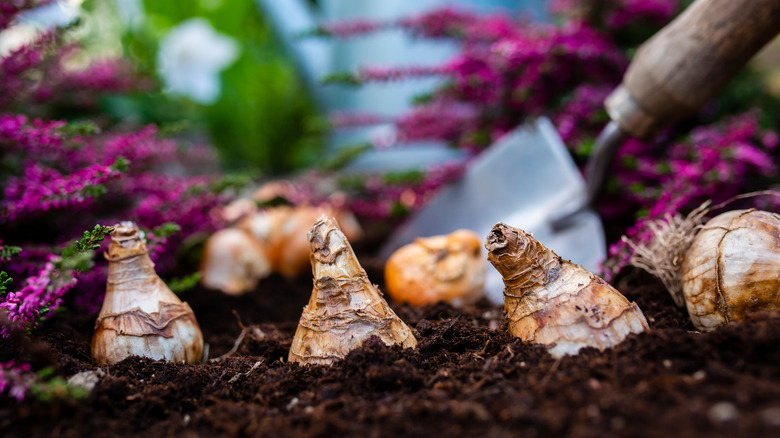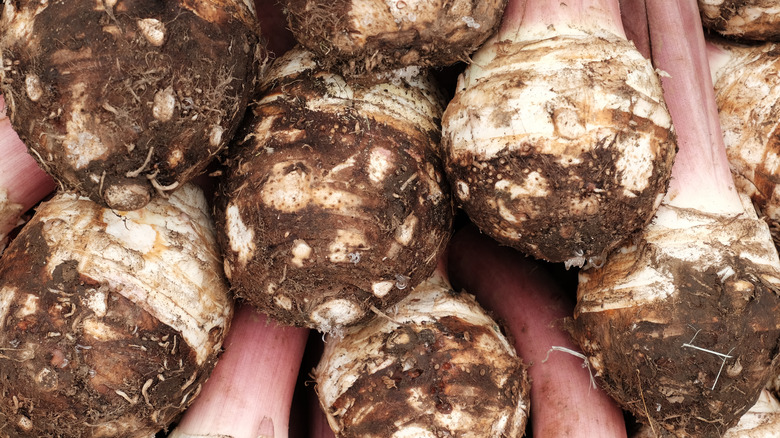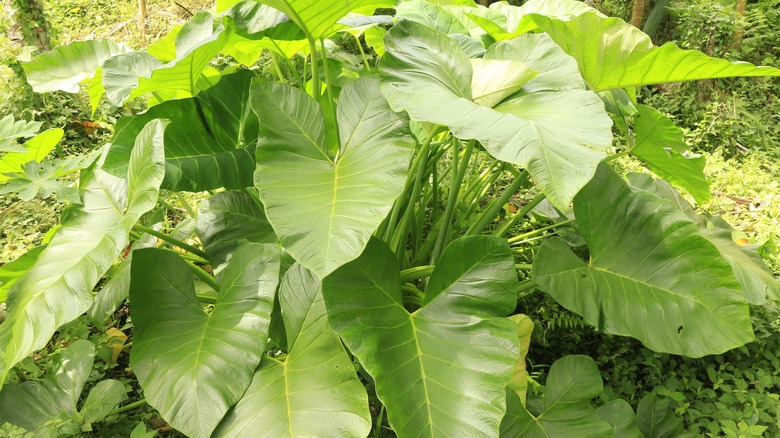The Best Time Of Year To Plant Elephant Ear Tubers, And How To Do It
We may receive a commission on purchases made from links.
Elephant ear plants don large-sized, other-worldly-looking leaves. Their resemblance to an elephant's ear is easy to see, mainly due to their size and shape, with some plant leaves getting up to two feet wide and ranging in color from deep purple and black to bright and dark green, with pops of color in pink and white. The elephant ear plant is the common name for a group of aroid plants: Colocasia, Caladium, Alocasia, and Xanthosoma — all of which feature gigantic foliage. Despite being native to parts of Asia, the Pacific Islands, and the tropical Americas, these plants can grow in USDA hardiness Zones 3 through 8 as annuals and higher zones as perennials.
Interested gardeners can find tubers of a few show-stopping elephant ear varieties online at Longfield Gardens for less than $40. Elephant ear tubers, more often referred to as elephant ear bulbs, are what give life to these tropical aroids. True bulbs hold the entire plant within the bulb, like tulips and daffodils, but tubers are different; they are root stems that store essential food and nutrients for the plant.
For those who want to try their hand at growing elephant ear tubers themselves, the best time to plant them varies from region to region. As a general rule, they should be sown in the spring after the threat of frost has passed. That said, take care to only do so at just the right time for your specific area, to save your yard from losing its fresh look this summer.
What month do you plant elephant ear bulbs?
In colder climates, you may not be able to plant elephant ear bulbs until May or June. The soil temperature must be at least 65 degrees Fahrenheit for elephant ears to actually grow. To check the temperature of your soil, use a soil thermometer. You can find a 4-in-1 soil tester on Amazon for $22. This soil tester measures soil moisture, temperature, pH, and sunlight. With this tool, you can plan the best time to plant your elephant ear bulbs (tubers) based on an accurate soil temperature in your area.
The last frost date in your area will depend on what USDA Hardiness Zone you're in. These last frost dates are variable and based on previous climate data in each region. Frost is a significant threat to plants, especially tropicals like elephant ears. It damages your plants and may entirely wipe them out, depending on the temperatures. Your local weather and climate report can give you the best idea of when the final frost date is in your area.
Do elephant ear bulbs come back every year?
As mentioned, elephant ears are a tropical plant, so as annuals in colder regions, they'll only survive one growing season and won't survive the winter. Their bulbs must be dug up, stored, and replanted for the following year. You can also care for elephant ears by planting them in pots and bringing them inside in the winter. In USDA hardiness zones 9 through 11, elephant ears are perennials and will come back every year because of the milder climate and temperature during the winter.
Digging up and replanting elephant ear tubers is relatively simple. Cut off all the leaves and stems by cutting directly above the ground a week or two before the first frost date in the fall. Then, gently dig up the tubers and pull them out, leaving whatever roots have formed, trimming them as needed. Wash them well with water to remove all the dirt, and let the bulbs dry in a cool, dark area. After a week of drying, you can prep them for storage through the winter. Wrap them in paper, store in a box, and check on them every few weeks. If you notice any disease or pests, spray the elephant ear tubers with neem oil and let them dry out before re-wrapping. Wait until the soil reaches the right temperature in the spring before planting the tubers again. Do not soak them in water before planting. This popular planting myth can lead to pathogens and rotting.


